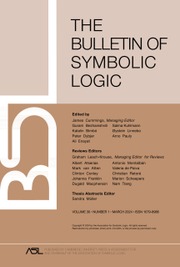No CrossRef data available.
Paradoxical sets and the Axiom of Choice
Published online by Cambridge University Press: 20 November 2025
Abstract
The thesis is thematically divided into two parts: Algebraic closures of certain subfields of the reals (Part I) and Paradoxical sets of reals (Part II). Part I investigates a folklore result about the forcing extension by one Cohen real: the transcendence degree of the reals over the set of reals in the ground model is of cardinality  $\mathfrak {c}$ (in the extension). We extend this to the case in which more Cohen reals are added, obtaining the following result:Theorem A.
$\mathfrak {c}$ (in the extension). We extend this to the case in which more Cohen reals are added, obtaining the following result:Theorem A.
Let X be a finite set of mutually generic Cohen reals over V. In  $V[X]$, consider the minimum field
$V[X]$, consider the minimum field  $F\subseteq \mathbb {R}$ such that
$F\subseteq \mathbb {R}$ such that  $F\supseteq \bigcup _{Y\subsetneq X} \mathbb {R}^{V[Y]}$. Then, in
$F\supseteq \bigcup _{Y\subsetneq X} \mathbb {R}^{V[Y]}$. Then, in  $V[X]$ the transcendence degree of
$V[X]$ the transcendence degree of  $\mathbb {R}$ over F is continuum.
$\mathbb {R}$ over F is continuum.
In Part II, we consider some paradoxical sets of reals and study their interaction with the Axiom of Choice. Informally, paradoxical sets are subsets of  $\mathbb {R}^n$ that can be constructed using the Axiom of Choice. In this work we focus on the following examples of paradoxical sets: Hamel bases of
$\mathbb {R}^n$ that can be constructed using the Axiom of Choice. In this work we focus on the following examples of paradoxical sets: Hamel bases of  $\mathbb {R}$ as a
$\mathbb {R}$ as a  $\mathbb {Q}$-vector space, two-point sets or Mazurkiewicz sets, and partitions of
$\mathbb {Q}$-vector space, two-point sets or Mazurkiewicz sets, and partitions of  $\mathbb {R}^3$ into unit circles (PUC). The known proofs of existence of these objects rely on a transfinite induction on a well-order of the reals.
$\mathbb {R}^3$ into unit circles (PUC). The known proofs of existence of these objects rely on a transfinite induction on a well-order of the reals.
The main question considered through this work is the following: Can we recover some weakening of the Axiom of Choice from the existence of a particular paradoxical set? This thesis gives negative answers for different versions of this question, changing the particular paradoxical set, and the weakening of the Axiom of Choice considered. Furthermore, the main contribution of this thesis is the development of a framework that produces some of these answers and recovers other known results of similar form. In particular we obtain the following applications:Theorem B.
There is a model of  $\mathsf {ZF}+\mathsf {DC}$ with a Hamel basis and no free ultrafilter on
$\mathsf {ZF}+\mathsf {DC}$ with a Hamel basis and no free ultrafilter on  $\omega $.
$\omega $.
There is a model of  $\mathsf {ZF}+\mathsf {DC}$ with a partition of
$\mathsf {ZF}+\mathsf {DC}$ with a partition of  $\mathbb {R}^3$ in unit circles but without a wellordering on the reals.
$\mathbb {R}^3$ in unit circles but without a wellordering on the reals.
Abstract prepared by Azul Fatalini
E-mail: A.L.Fatalini@leeds.ac.uk
URL: https://nbn-resolving.org/urn:nbn:de:hbz:6-53948487632
Current affiliation: UNIVERSITY OF LEEDS
Keywords
MSC classification
Information
- Type
- Thesis Abstract
- Information
- Copyright
- © The Author(s), 2025. Published by Cambridge University Press on behalf of The Association for Symbolic Logic
Footnotes
Supervised by Ralf Schindler.


